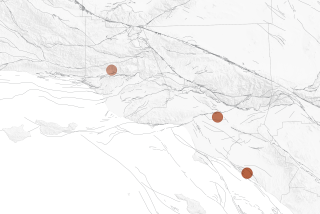Seismologist tried to predict quakes
Vladimir Keilis-Borok, an internationally known seismologist and geophysicist who never wavered in his dogged pursuit of what he called his professionâs âholy grailâ -- a method to accurately predict earthquakes -- died Saturday at his Culver City home after a long illness. He was 92.
His death was announced by UCLA, where he had been a professor since 1998.
The eminent Russian scientist garnered headlines after two large temblors -- in Japan and Central California -- occurred in 2003 within the time frame forecast by his international team of earthquake experts.
So when Keilis-Borok announced that a magnitude 6.4-or-larger quake would strike before Sept. 5, 2004, in a 12,000-square-mile area of the Mojave Desert, skeptical colleagues who had long regarded earthquake prediction as shaky ground were intrigued.
That big one, however, never came, causing some experts to scoff that Keilis-Borok had simply been lucky the first two times.
Others have not been so quick to dismiss his work.
âHe pushed the envelope on earthquake prediction,â said John Vidale, a former UCLA geophysicist who is now director of the Pacific Northwest Seismic Network, a group based at the University of Washington that monitors seismic activity. âA lot of people had shied away from it because it failed in the â70s. He helped focus our interest on earthquake prediction.â
Keilis-Borok and his team identified patterns of seismic activity using mathematical algorithms. Their predictions were based on finding a âseismic chain,â or series of smaller quakes, that could be a precursor to a major jolt. He called this methodology âtail wagging the dog.â
âWe look backward to make our earthquake predictions,â he said in January 2004 when he went public with the prediction of a major quake in the Mojave in the next nine months.
He was the first to acknowledge that his teamâs predictions had only a 50-50 chance of being right. Yet scientists such as Vidale said that a system that was accurate only 50% of the time would be a vast improvement over previous attempts at prediction.
One of the most embarrassing failures had been a prediction in the early 1980s by researchers at the U.S. Geological Survey that a temblor of magnitude 6 or higher would strike along the San Andreas fault at Parkfield in Monterey County in 1988.
That quake failed to materialize. Earthquake forecasting receded into the margins of seismological research until Keilis-Borok and his team scored two successive hits.
In July 2003 they said a magnitude 7 or higher quake would rock an area of northern Japan before the end of the year. On Sept. 25, 2003, a magnitude 9.1 quake struck Japanâs northernmost island injuring hundreds.
The team also predicted that a quake of magnitude 6.4 or higher would strike in a 310-mile stretch between Fort Bragg, Calif., and Cambria, Calif., by 2004. In December 2003 a magnitude 6.5 quake struck six miles northeast of San Simeon, on the southern edge of the prediction zone, killing two people.
Their calculations drew serious scrutiny, including a review by a state panel of earthquake experts who said the teamâs methodology was sound. It was the first time since the Parkfield prediction that the scientific community didnât dismiss quake forecasting as nonsense.
Experts at USC and elsewhere are refining and testing prediction systems, including methods developed by Keilis-Borokâs team. His highly publicized predictions were âsomething of a motivating factorâ in the founding several years ago of an international research project on earthquake predictability at the USC-based Southern California Earthquake Center, spokesman Mark Benthien said.
Born in Moscow on July 31, 1921, Keilis-Borok was the only child of Russian Jews. His father was a merchant, his mother a secretary. When the Germans invaded Russia during World War II, he was sent to the front to install communication lines. He was later assigned to search for oil in eastern Russia. After the war Keilis-Borok studied at the Russian Academy of Sciences, earning a doctorate in 1948, and taught computational geophysics.
In the 1960s, during the Cold War, he studied seismic waves from underground nuclear explosions and compared them to the motion caused by earthquakes.
He participated in the 1963 U.S.-Soviet arms-control talks, contributing his expertise on the differences between earthquakes and underground nuclear explosions.
By the 1980s he was immersed in earthquake prediction theory and founded a research institute in Moscow. He divided his time between Moscow and L.A. after joining UCLA in 1998.
In his spare time, Keilis-Borok turned his analytical skills on other phenomena, including presidential elections. After meeting American University historian Allan J. Lichtman in 1981 when both were visiting professors at Caltech, he proposed a collaboration to use his quake prediction methods to forecast the outcome of presidential contests.
âI said, âWow, that sounds a little odd,ââ Lichtman recalled in an interview this week. âBut his methodology,â he said, âwas perfected suited to my theory,â which examined patterns associated with upheaval or stability in the political environment. According to Lichtman, his work with Keilis-Borok has accurately divined the winner of the popular vote in every presidential election since 1981.
âIt was one of the triumphs of his career,â Lichtman said, adding the scientist âwould have liked to have gotten more credit for his earthquake predictions.â
When the earth failed to move in the Southern California desert in 2004, Keilis-Borok remained philosophical about the setback. âTo quote Churchill,â he told The Times a few days after the deadline passed without event, âThis is not the beginning of the end, itâs the end of the beginning.â
He is survived by a daughter, Irina Kashin, a granddaughter and two great-grandchildren.
--
More to Read
Sign up for Essential California
The most important California stories and recommendations in your inbox every morning.
You may occasionally receive promotional content from the Los Angeles Times.











